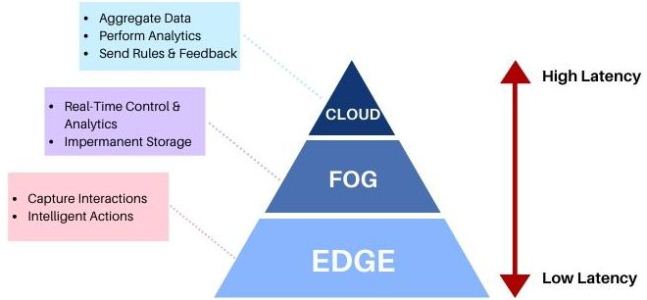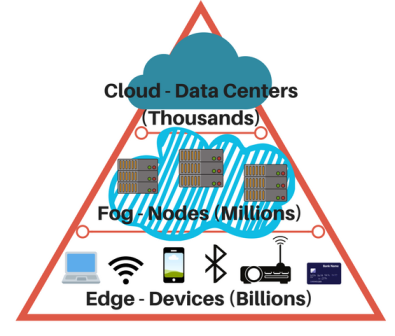From Cloud Computing To Edge Computing
- 02 Nov 2019
- According to a research, by 2025, companies will generate and process more than 75% of their data outside of traditional centralised data centres- that is, at the “edge” of the cloud.
- Internet of Things (IoT) devices are generating vast volumes of dataand approximately 80 billion devices will be connected to the internet by 2025.
- In this backdrop, cloud-based systems cannot handle the massive rush of data, which gives way to Edge Computing.
Edge Computing
- Edge computing is a distributed, open IT architecture that features decentralised processing power, enabling mobile computing and Internet of Things (IoT) technologies. Here, data is processed by the device itself or by a local computeror server, rather than being transmitted to a data centre.
- Simply put, edge computing enables data to be analysed, processed, and transferred at the edge of a network.
- The idea is to analyse data locally, closer to where it is stored, in real-time without latency, rather than send it far away to a centralised data centre. However, only the relevant data or information is collected and then sent, rather than all of the data collected.
- Edge computing plays a pivotal role as it brings computing power, control, storage and applications closer to end users.
- For ex. whether anyone is streaming a video on Netflix or accessing a library of video games in the cloud, edge computing allows for quicker data processing and content delivery.
Difference with Fog Computing and Cloud Computing
- The basic difference among the three lies in where the data processing takes place.
- At the moment, the existing Internet of Things (IoT) systems perform all of their computations in the cloud using data centres.
- Edge computing usually occurs directly on the devices to which the sensors are attached or a gateway device that is physically close to the sensors.That data doesn’t need to be sent over a network as soon as it processed; only important data is sent, reducing the amount of data that travels over the network.
- Fog computing moves the edge computing activities to processors that are connected to the local area network (LAN) or into the LAN hardware itself so they may be physically more distant from the sensors and actuators.
- In cloud computing, data is collected and analyzed in some centralized location where developers and operators have more control over processing and system communications.
Benefits
- Cost Effective: It allows for efficient data processing in that large amounts of data can be processed near the source, reducing Internet bandwidth usage. This both eliminates costs and ensures that applications can be used effectively in remote locations.
- Reduces Latency: Edge computing reduces data latency and trips between networks and devices, allowing smart applications and devices to respond to data almost instantaneously, as its being created, eliminating lag time. This is critical for technologies such as self-driving cars.
- Faster Response Time: The response times with edge computing is also faster, as it doesn’t need to go to the cloud, thus reducing the time it takes to gather actionable insights from data.
- Increased Data Security: Due to its ability to process data without ever putting it into a public cloud, edge computing adds a useful layer of security for sensitive data .It protects sensitive data and helps organisations have greater monitoring systems.
- Uninterrupted Connectivity:It allows smart devices and manufacturing equipment to operate without disruption, even if they’re offline or there’s intermittent connectivity.
- Works on Multiple Devices: whether devices are new or legacy, edge computing can covert communication protocols. This allows language from older devices to be converted into language that modern devices and the cloud can understand, which can also reduce new equipment costs.

Applications
|
Challenges
- Edge computing sites are usually remote with limited or no on-site technical expertise. If something fails on-site you need to have an infrastructure in place that can be fixed easily by non-technical local labor and further managed centrally by a small number of experts located elsewhere.
- Scaling out to many small sites can be more complicated than adding the equivalent capacity to a single core datacenter. The increased overhead of physical locations can be difficult for smaller companies to manage.
- Site management operations need to be highly reproducible across all edge computing sites to simplify management, allow for easier troubleshooting and to prevent the configuration of software implemented in slightly different ways at each of the sites.
- While edge computing offers greater control over information flows by constraining the data geographically, the physical security of the site is often much lower. This can lead to a greater risk of malicious or accidental situations (like a tripped cable).
Way Forward
- With specialized hardware, software, and developer environments, edge computing is likely to increase operational reliability, enable real-time predictions, and improve data security. The much anticipated 5G service, which promises lower latency and enhanced coverage and responsiveness and quantum computing, which accelerates computation, may further increase edge computing’s efficiency.
- However, the efficient distribution of the processing needs across the network of edge devices will be a challenge. Also, efficient scheduling of tasks will become essential in avoiding system failure and optimizing machine learning. Over time, it is expected that more powerful processing chips with lower power requirements will be available, and then AI-based edge computing will really shine.





